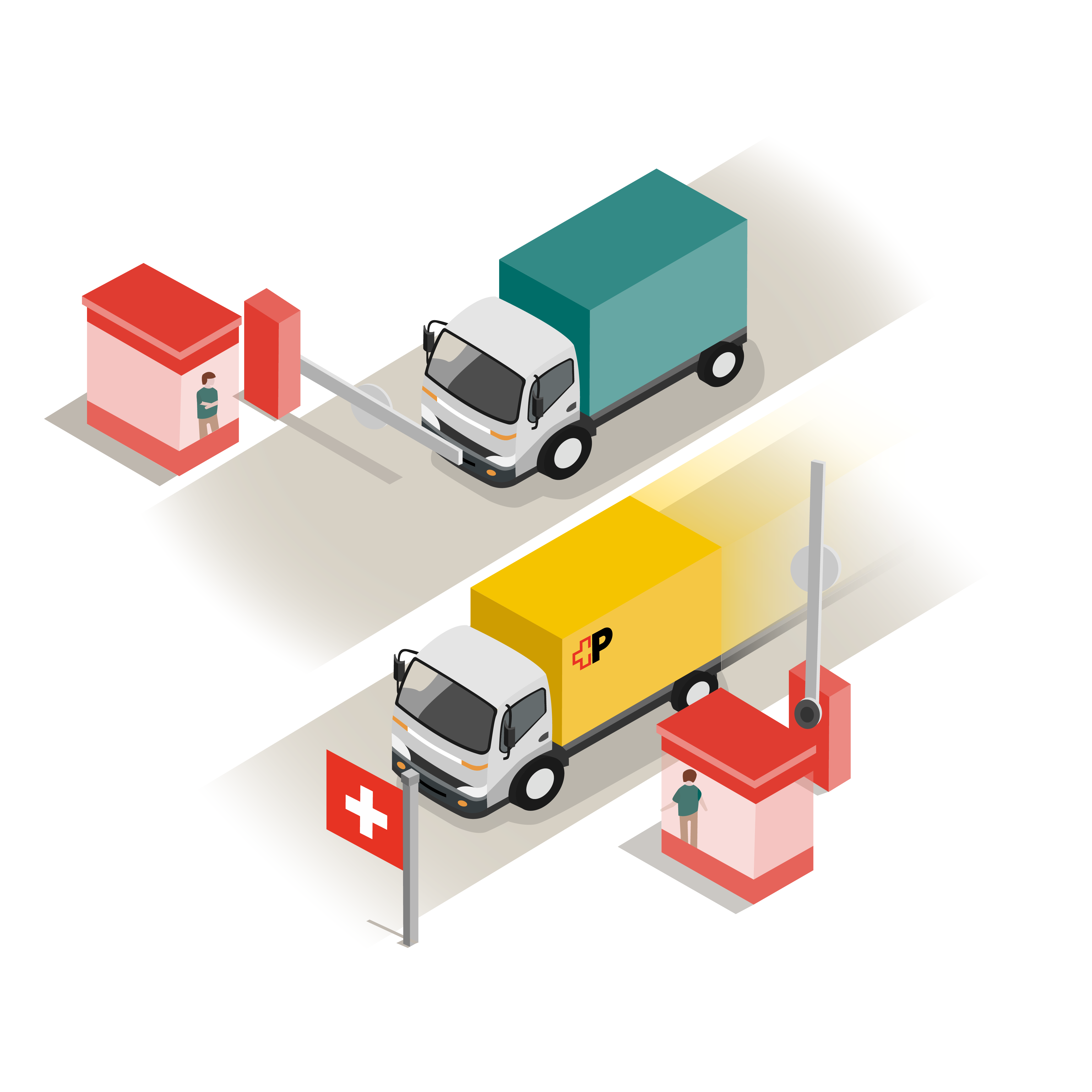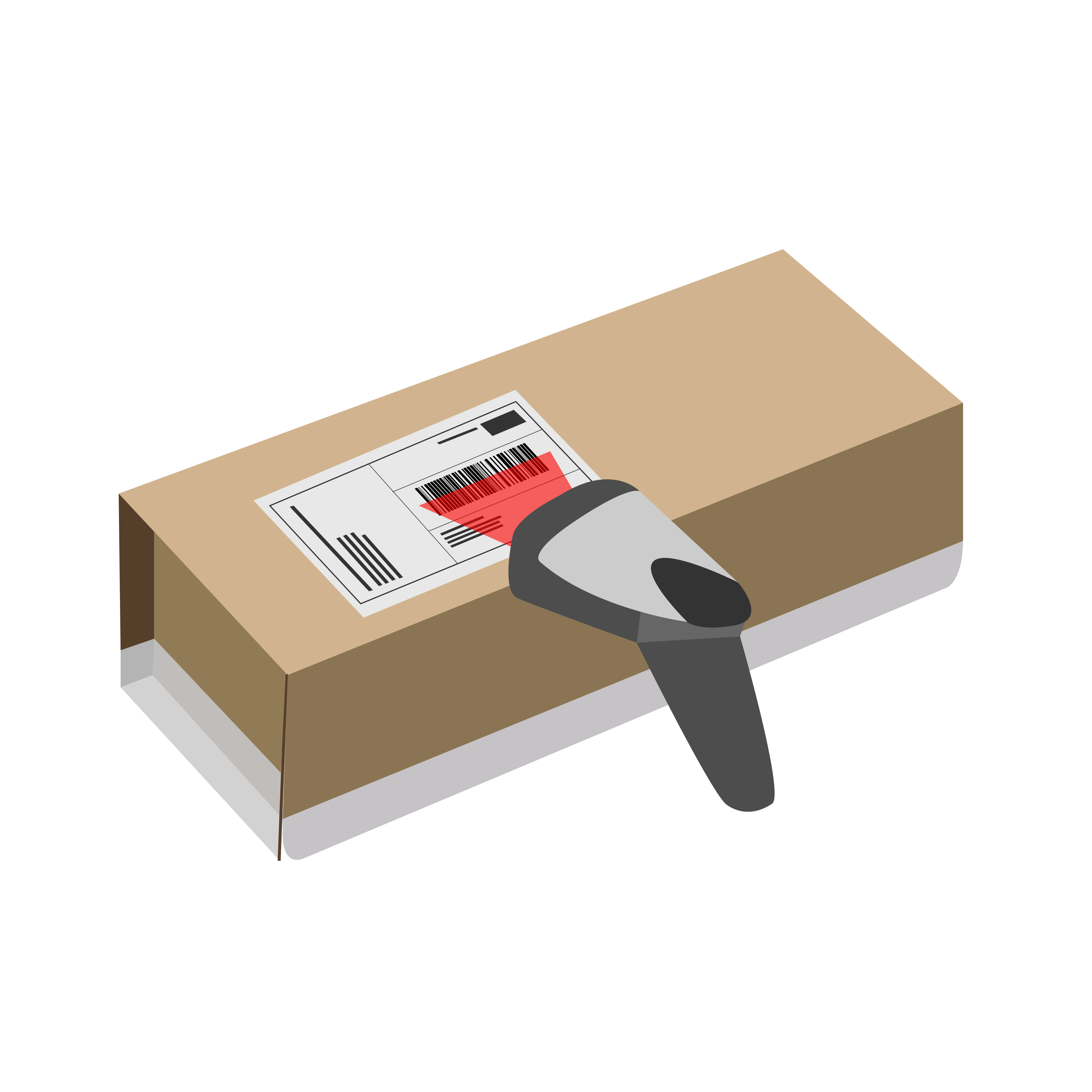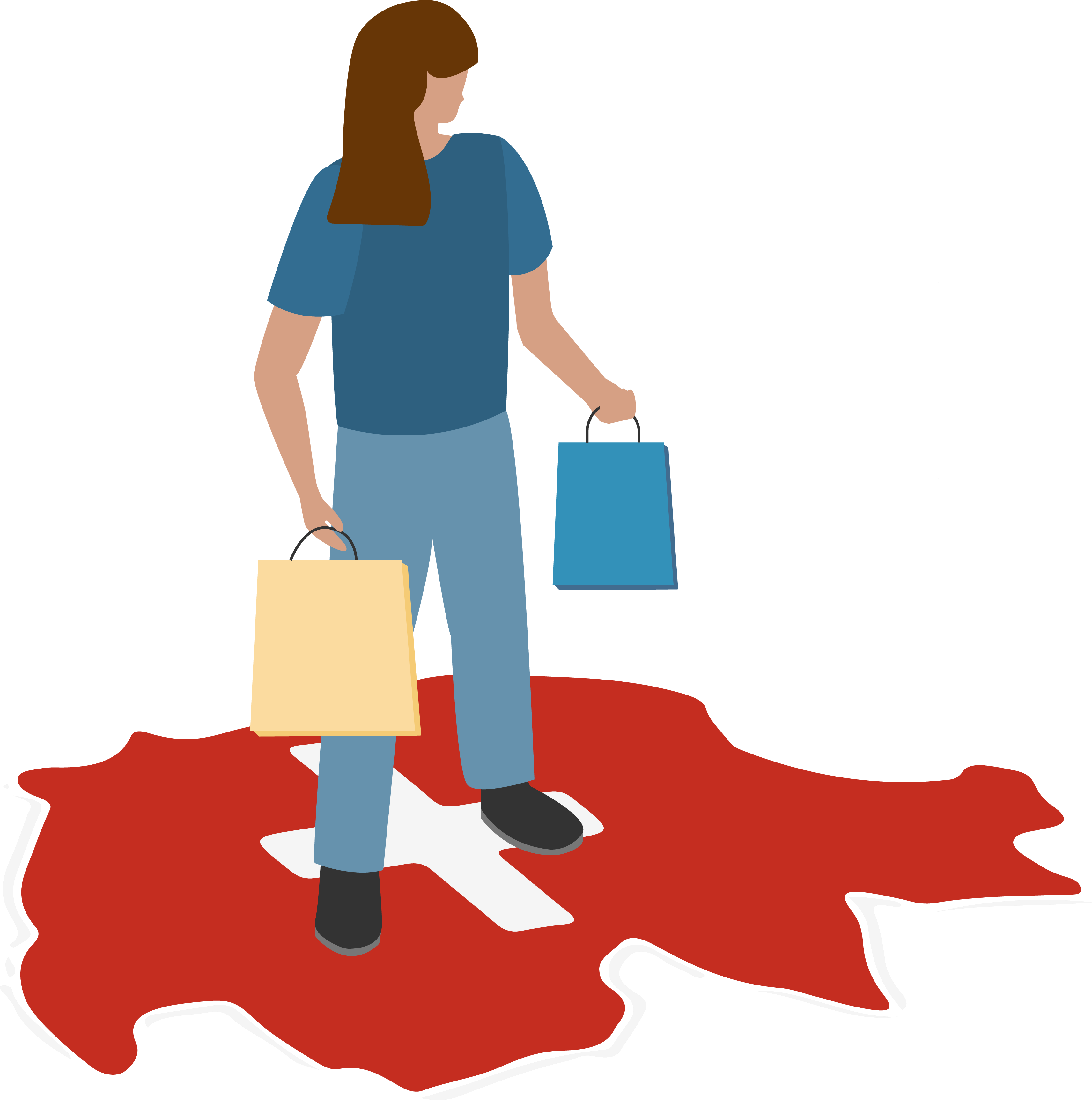Customs clearance to Switzerland: how it works

It's actually quite simple
It's actually quite simple: everything you send to Switzerland must be cleared for import. Everything that your customers return must be cleared for export. So far, so good.
But it wouldn’t be such a bureaucratic obstacle if things were really that simple. Different customs clearance methods, different types of calculation and country-specific regulations can create a real headache for the unprepared online retailer.
Of course, this raises a few questions: How do you process customs clearance for Switzerland as efficiently as possible? Where might you be able to save on costs? In the event of returns, how do you ensure you are reimbursed for any customs duty paid? Which documents are important?
You want to optimise your sending configuration? Book your consultation appointment now:
Ideally, customs clearance in Switzerland is processed as follows
As an online retailer, you usually find that you must also deal with returns. When shipping to Switzerland, however, this means two additional customs clearance processes – increasing the total number to four. That means four possible sources of errors and cost factors that you should try to minimize.
So the right customs clearance processing will save you money. How? Using the right customs clearance method (individual or collective customs clearance – see the example here) for your goods ensures that customs duties from export customs clearance are reimbursed, and that returns are not unnecessarily subjected to EU customs clearance when they are reimported into the EU.
So what would the optimal process for import and export customs clearance look like? It would comprise the following four steps:
- Export customs clearance EU: Goods shipped, followed by export customs clearance. A note is made of the Master Reference Number (MRN) – this is relevant for possible returns.
- Import customs clearance CH: Individual or collective customs clearance of the goods – depending on which is more cost-effective.
- Export customs clearance CH: Returns are cleared for export. The import duties are reimbursed – provided all information on the import is available.
- Import customs clearance EU: Returns are imported into the EU. If the MRN is provided, no new import duties are incurred.
As you can see, it is vital to provide the correct data to ensure that everything runs smoothly. Ideally, you should transfer these via API to the service provider who, in turn, forwards them to the relevant authorities – this reduces individual errors and saves time.
Mailbox Plus provides exactly this option. Take another look at the process in the graphic:
/Import%20Ein%20und%20Ausfuhrverzollung/EN/export%20to%20and%20from%20Switzerland.png?width=1000&height=865&name=export%20to%20and%20from%20Switzerland.png)
When do customs duties apply? And when do your customers have to pay and when will you bear the costs and customs duties? Among other things, this depends on the Incoterms DDP and DAP. See our blog to learn more!
Export customs clearance: many routes into Switzerland
There are basically two options for customs clearance in Switzerland: the one-stage procedure and the two-stage procedure. In the latter case, the goods must be provided for possible customs controls at the export customs office for 24 hours before they are transferred to the customs office of exit and then to Switzerland. The one-stage export procedure dispenses with this intermediate step.
One-stage procedure
For small consignments with a value less than EUR 3,000 and which are not subject to any political, economic or other restrictions, the one-step export procedure is used. The export declaration is then sent directly to the customs office of exit.
The restrictions mentioned above include, for example, trade policy measures (export permit requirements, license requirements), bans (endangered species protection, waste disposal legislation) or an embargo on the destination.
This method is therefore very practical for unproblematic small consignments, as it saves time.
Two-stage procedure
The key benefit here, is that the actual goods checks do not take place at the border, but at the export customs office itself. This is usually not far from the place where the goods are loaded, as this is just the most practical location from a logistical point of view. This means that only random checks are required when crossing the border to ensure that everything is in order.
The German customs administration also offers a search to find the responsible office. But it also requires a 24-hour presentation period for this purpose. In other words, the goods must be made available for customs checks for 24 hours at a location approved by customs (i.e. at the export customs office or another approved location). This can also be your own warehouse.
You must submit the export declaration by 12 noon sharp. Hand it in a minute later and you’ll have to wait until the following day. So timing is everything. This export declaration applies to all modes of transport and must be submitted electronically using ATLAS customs software.
Pro tip
If you are exporting to Switzerland via France, there is no presentation period. So you gain a day! The same is true if the merchant has the “approved exporter” status.
Pro tip
If you are exporting to Switzerland via France, there is no presentation period. So you gain a day! The same is true if the merchant has the “approved exporter” status.
What happens at the customs office of exit?
For both the one-step and two-step export procedures, this is where the MRN of the electronic export declaration and possibly the export accompanying document (EAD) are presented. The customs office of exit then checks whether the goods match the declaration.
Were the goods checked beforehand by the export customs office? An additional data record is then transmitted, on the basis of which the customs office of exit can carry out a risk analysis. If everything is in order, the goods can leave the customs area of the European Union and be imported into Switzerland.
This prevents the border crossing itself from becoming a bottleneck for the flow of goods – simply because many consignments have already been checked in advance. Spot checks will, of course, still be conducted.
Do you find Swiss customs regulations difficult to understand? That ends now! We tell you everything you need to know about customs.
Example: Export clearance from Germany with a goods value over EUR 3,000
As an online retailer, you usually have to follow the two-step procedure, as you don’t want to send every parcel to Switzerland individually (which would be unnecessarily expensive and time-consuming). So, for the purposes of our example, you soon reach the goods value of EUR 3,000.
The process is then as follows:
/Import%20Ein%20und%20Ausfuhrverzollung/EN/practical%20export%20customs.png?width=1000&height=595&name=practical%20export%20customs.png)
In this case, you provide the service provider with all the data and documents they need for export customs clearance. This usually also includes a commercial invoice. The service provider uses this information to submit the electronic export declaration via the ATLAS system. Everything then proceeds in the usual way and the goods arrive in Switzerland, where they are cleared for import.
Of course, it is an advantage here if the same service provider that performed the export customs clearance now also handles the import customs clearance – after all, they already have all the necessary data. This saves you time and effort!
Variants of two-step export customs clearance
Here, it becomes clear once again just how useful it is to commission a service provider for customs clearance (and all the other associated tasks). Because getting these tasks right can save you a lot of money.
Variant 1: Do it yourself. This means the place of loading and packaging is your warehouse, which is why you must submit the customs declaration to the responsible export customs office in your region – not forgetting the 24 hours presentation period.
Variant 2: You commission a 3PL provider such as Swiss Post. They can combine your consignments for combined shipment and customs clearance – this massively reduces your unit costs. The provider just needs a “transfer of authority” from you. They can then perform the export declaration in their own region.
For you this means less stress, lower costs, and more time to spend on your core business!
/Import%20Ein%20und%20Ausfuhrverzollung/EN/two%20stage%20export.png?width=1000&height=766&name=two%20stage%20export.png)
Flexible exporting with Swiss Post
Most retailers are either well below the EUR 3,000 limit or well above it – that makes the choice of export customs clearance quite easy. But what if you don’t know whether the value of your consignments will exceed EUR 3000?
In this case, as always, you can count on Swiss Post! We adapt flexibly to your needs and declare your goods exactly according to the legal requirements. It doesn’t matter if you’re below the limit today and above it tomorrow – relax and let us take care of it for you!
All you have to do is send us all the relevant data and we will take care of the export customs clearance – one-step or two-step.
/Import%20Ein%20und%20Ausfuhrverzollung/EN/one%20stage%20two%20stage.png?width=1000&height=464&name=one%20stage%20two%20stage.png)
The advantages for you
- Lower costs: You save money with the efficient use of our letter and parcel channels. Find out more in our blog Reducing shipping costs in cross-border e-commerce.
- Excellent know-how: Swiss Post knows its way around Switzerland better than anyone – you also benefit from that.
- Less effort: Easy integration of all customs clearance processes via API interface
- Minimized tax burden: An optimal setup ensures the most favourable conditions!
Your customers won’t even notice that you’re shipping from Germany or Austria – to them, the customer journey will feel the same as if they ordered directly from Switzerland.
The same applies to returns: with our first-mile returns solution, returns are accepted at 4,500 acceptance points and we send them back to you in combined shipments. Maximum convenience for your customers, minimum costs for you!
And what’s good for your customers is good for you too! With the right customs clearance for Switzerland, you will increase your recommendations, conversions and repurchase rates.
Individuelle Lösungen für einzigartige Bedürfnisse
Mit der persönlichen Beratung zum optimalen Versand- und Logistiksetup
Bei der Schweizerischen Post verstehen wir, dass jeder Markt seine eigenen, einzigartigen Herausforderungen hat. Deshalb sind wir hier, um Dich beim Export in die Schweiz oder beim Export aus der Schweiz zu unterstützen. Mit unserer umfassenden Erfahrung und unserem massgeschneiderten Ansatz finden wir gemeinsam die optimale Lösung für Dein Versand- und Logistik-Setup.
Warum einen Beratungstermin bei uns buchen?
-
Massgeschneiderte Lösungen
-
Umfassende Expertise
-
Einfacher Prozess
-
Vertrauenswürdiger Partner
Customised solutions for unique needs
Personalised advice for the optimal shipping and logistics setup
At Swiss Post, we understand that every market has its own unique challenges. That's why we're here to help you export to or from Switzerland. With our extensive experience and customised approach, together we will find the optimal solution for your shipping and logistics setup.
Why book a consultation with us?
- Customised solutions
- Comprehensive expertise
- Simple process
- Trusted partner
Des solutions personnalisées pour des besoins uniques
Un conseil personnalisé pour une configuration optimale de l'expédition et de la logistique
A la Poste Suisse, nous comprenons que chaque marché a ses propres défis uniques. C'est pourquoi nous sommes là pour vous aider à exporter vers la Suisse ou à exporter depuis la Suisse. Grâce à notre vaste expérience et à notre approche sur mesure, nous trouverons ensemble la solution optimale pour votre configuration d'expédition et de logistique.
Pourquoi réserver un rendez-vous de conseil avec nous ?
- Des solutions sur mesure
- Une expertise complète
- Processus simple
- Un partenaire de confiance
Soluzioni personalizzate per esigenze uniche
Consulenza personalizzata per l'impostazione ottimale della spedizione e della logistica
Noi della Posta Svizzera sappiamo che ogni mercato ha le sue sfide uniche. Ecco perché siamo qui per aiutarla ad esportare da o verso la Svizzera. Grazie alla nostra vasta esperienza e all'approccio personalizzato, insieme troveremo la soluzione ottimale per il suo setup di spedizione e logistica.
Perché prenotare una consulenza con noi?
- Soluzioni personalizzate
- Competenza completa
- Processo semplice
- Partner affidabile




